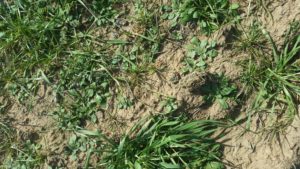by Dr. Clark Neely, Small Grains Extension Specialist, Texas A&M AgriLife Extension Service

Figure 1. Photo of cutleaf eveningprimrose in wheat field (courtesy Xandra Morrison, AgriLife IPM Agent).
Despite the fact that we are still in mid-winter, late January in southern Texas through early March in the Panhandle is the ideal time for not only topdressing wheat, but also taking care of any persistent weed problems in your wheat fields before the spring green-up. This article will cover some of the new herbicides hitting the market that are labelled for wheat and where they might be most useful. While we did not see any change in 2016 for grassy weed control options, there are a number of new options now available for broadleaf weed control in wheat. In 2016, there were four new herbicide products approved or released for broadleaf weed control in wheat. They include Quelex, Talinor, Sentrallas and Travallas.
Quelex is a Dow AgroSciences product that targets postemergence control of broadleaf weeds in wheat, barley and triticale. It combines florasulam, which is an ALS Inhibitor, with a brand new active ingredient referred to as Arylex. This new active ingredient, Arylex, falls into the group 4 mode of action, also known as synthetic auxins. The other active ingredient, florasulam, is the same ingredient that can be found in Orion or Axial TBC herbicides. This product allows for flexible crop rotations as plant back restrictions are only 3 months for cotton, corn, sorghum, and oats and no restrictions for wheat, barley and triticale. Rotation crops do not need to be STS or ALS tolerant. Quelex is labelled for control of many major broadleaf weeds encountered in wheat in Texas including, but not limited to wild buckwheat, common chickweed, henbit, marestail, field pennycress, sheperdspurse, and six different mustard species. It will also suppress growth of field bindweed, kochia, prickly lettuce, sowthistle, and Canada thistle. The label specifies an application rate of 0.75 oz/a/year and applied anywhere from the 2-leaf stage in wheat through flag leaf emergence. Ideally weeds should have 2-4 leaves and be smaller than 4 inches in height. Preharvest intervals include 7 days between application and grazing, 21 days before haying, and 60 days before grain harvest. Quelex can be tank mixed with up to 100% fluid fertilizer; however Quelex cannot be tank mixed with any products containing glufosinate.
Talinor is a Syngenta product that fills a similar niche as Quelex, but uses different chemistry. Talinor targets postemergence control of annual broadleaf weeds in wheat and barley using 2 active ingredients: bicyclopyrone and bromoxynil. Bicyclopyrone is a group 27 herbicide and is already used in the corn market as part of the Acuron product released in 2015. Bromoxynil is the same active ingredient found in Huskie and Buctril 4EC, which is a photosynthetic inhibitor. This product is not as flexible in crop rotations as Quelex, but should not be problematic except for potentially soybean and cotton in double crop situations. Plant back restrictions include 1 month for wheat, 9 months for triticale, 12 months for soybeans, and 10 months for sorghum and cotton. Corn can be planted anytime following application. For the most part, Talinor is labelled to control a similar spectrum of broadleaf weeds as Quelex with some exceptions. Talinor should provide better control of kochia, prickly lettuce, and sowthistle; but is less active on controlling henbit. Application rate is 13.7 to 18.2 fl oz/a/year and timing runs anywhere from the 2-leaf stage in wheat through pre-boot stage. Preharvest intervals include 30 days between application and grazing or haying and 60 days before grain harvest. Talinor will be co-packed with CoAct+™ additive in a dual-chambered jug. Talinor should not be tank mixed with ammonium sulfate containing products as severe crop injury can occur. Crop oil concentrate is preferred but a non-ionic surfactant can be substituted. There are a number of both broadleaf and grass herbicides labelled for tank mixing with Talinor. Some grass herbicides include Axial XL, Olympus Flex, Osprey, Powerflex and Maverick. Talinor possesses limited residual control and only controls emerged broadleaves. Production begins in mid-March of 2017, so product is not yet available to producers.
Sentrallas and Travallas are two new products offered by DuPont for wheat and barley (Sentrallas is also labelled for oats), though Sentrallas will be the primary product sold in Texas. Both products are new mixes, but are not new chemistries. Sentrallas is more versatile in a crop rotation and includes the active ingredients thifensulfuron and fluroxypyr. Thifensulfuron can be found in other products such as Affinity, Ally Extra, and Harmony Extra while fluroxypyr is the active ingredient in Axial Star and Starane Ultra. Travallas possesses the same two active ingredients as Sentrallas plus a third active ingredient – metsulfuron – which reduces cropping flexibility, particularly if soil pH exceeds 7.9. Alternatively, Sentrallas has limited restrictions on crop rotations with a maximum restriction of 120 days for any crop. The application rate for Sentrallas ranges from 7 to 14 oz/a for wheat and barley, while Travallas should be applied at only 7 oz/a. Grazing and harvesting restrictions are the same for both products and include 7 days before grazing after application, 30 days for haying and 45 days for grain harvest. Both products control most mustards except for tansymustard which they suppress. Other major weeds controlled include, but are not limited to, common buckwheat, common chickweed, field pennycress, Russian thistle, and shepherdspurse. Kochia and prickly lettuce are controlled at higher rates. Sowthistle, marestail, and henbit are suppressed but not controlled.
Other products that are relatively new, but have been available for a few years include Zidua, Anthem Flex, and Sharpen. Zidua, a BASF product, and Anthem flex, which is an FMC product, share the active ingredient pyroxasulfone, while Anthem flex also includes carfentrazone. These two products are labelled for delayed pre-emergence or early post-emergence applications once wheat has germinated. Zidua is only effective against non-germinated weed seed, while Anthem Flex has some additional burndown activity on broadleaves due to the carfentrazone. These products are quite effective at controlling a number of broadleaf weeds, but timing is critical. Applying too early will damage ungerminated wheat seed, and applying too late will fail to control weeds. These products are good options if looking for something with good residual activity.
Alternatively, Sharpen is an effective burndown herbicide for broadleaves offered by BASF with only limited residual activity. There are very few plant back concerns with this product and it is labelled for wheat, triticale, barley, oat and rye. Tank mixing with Roundup gives control of grassy weeds.
Always run a jar test before mixing herbicides with other products or fertilizers to ensure compatibility. For more information contact your local sales rep or visit www.cdms.net for an extensive list of herbicide labels for these and other herbicide products.

Clark Neely
State Small Grains Agronomist
College Station, TX
cbneely@tamu.edu